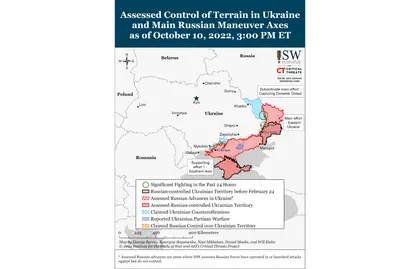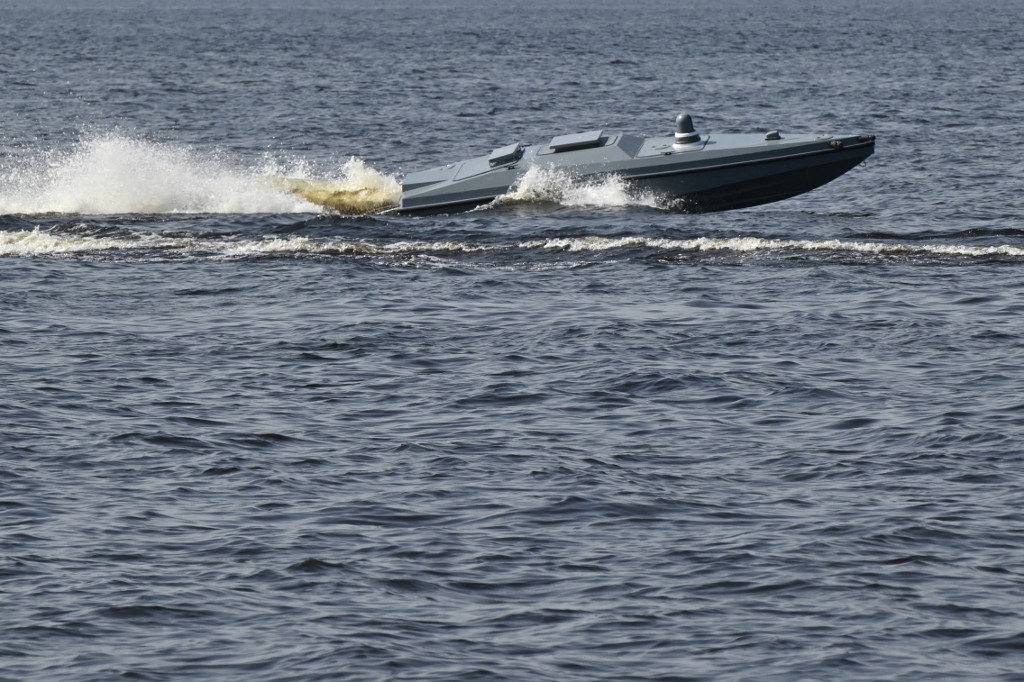Key Takeaways
- Russian forces conducted massive, coordinated missile strikes on over 20 Ukrainian cities.
- President Vladimir Putin claimed that the coordinated missile strikes were in retaliation for the explosion on the Kerch Strait Bridge, likely in part to curry favor with “pro-war” factions.
- Russian and Belarusian ground forces remain unlikely to attack Ukraine from Belarusian territory to the north.
- Ukrainian forces have likely liberated over 200 square kilometers of territory in western Luhansk Oblast as of October 10.
- Russian forces continued unsuccessful attempts to regain recently lost territory in northwest Kherson Oblast while reinforcing nearby positions with damaged and hastily mobilized units.
- Russian forces continued ground attacks in Donetsk Oblast.
- Russian and occupation administration officials are setting conditions to move up to 40,000 residents out of Kherson Oblast to Russian-occupied Crimea and the Russian Federation.
- Russian forces cannot supply mobilized forces, likely due to years of supply theft by contract soldiers and commanders.
Russian forces conducted a massive missile strike attack against over 20 cities, including Kyiv, on October 10. The Ukrainian General Staff reported that Russian forces launched over 84 cruise missiles and 24 drone attacks, 13 of which were carried out with Iranian-made Shahed-136 drones.[1] Ukrainian air defense shot down 43 cruise missiles, 10 Shahed-136 drones, and 3 unspecified drones. Russian forces launched missiles from 10 strategic bombers operating in the Caspian Sea and from Nizhny Novgorod, Iskander short-range ballistic missile systems, and 6 missile carriers in the Black Sea.[2] Russian forces launched the Shahed-136 drones from Crimea and Belarus.[3] Ukrainian media reported that Russian missile strikes hit 70 targets, including 29 critical infrastructure facilities, 4 high-rise buildings, 35 residential buildings, and a school.[4]
JOIN US ON TELEGRAM
Follow our coverage of the war on the @Kyivpost_official.
Russian President Vladimir Putin claimed to have ordered the missile strikes on Ukrainian infrastructure in retaliation for a “terrorist act” at the Kerch Strait Bridge, likely in part to curry favor with the Russian pro-war nationalist camp that has been demanding such retaliation.[5] Putin accused Ukraine during his meeting with the Russian Security Council of conducting terrorist acts against Russian civilian and critical infrastructure, namely against the Kerch Strait Bridge, the Kursk Nuclear Power Plant (NPP), and segments of the Turkish Stream gas transmission system.[6] Ukrainian officials have not formally taken responsibility for the explosion at the Kerch Strait Bridge.[7] The Ukrainian Main Military Intelligence Directorate (GUR) also reported that Putin has been planning this attack prior to the Kerch Strait Bridge explosion, and if true, could indicate that Putin planned this attack for the deflection of the Kharkiv-Izyum-Lyman failures.[8]

‘One of Moscow’s Biggest Defeats’ – Ukraine at War Update for Jan 2
Russian Defense Minister Sergey Shoigu also attended the meeting despite speculations that Putin would force him to resign, which may suggest that Putin settled on responding to only one of the pro-war community’s demands at this time.
Putin emphasized that he would conduct proportional escalation in any future retaliatory actions. He stated that if Ukraine continues to carry out “terrorist attacks against [Russian] territory, then Russian responses will be harsh, and their scale will correspond to the level of the threat to the Russian Federation.” This declaration of proportionality suggests that Putin intends to continue climbing the escalation ladder rung by rung and cautiously rather than jumping to more dramatic measures such as the use of nuclear weapons. Putin may also mean to message the Russian pro-war camp that they should manage their expectations of an ongoing daily bombardment of Ukraine similar to the one conducted today.[9] Russian milbloggers, for their part, have overwhelmingly welcomed the strikes and amplified Deputy Chairman of the Russian Security Council Dmitry Medvedev’s statement that more attacks against Ukraine will follow soon.[10] Ukrainian and Western intelligence have previously reported that Russia has spent a significant portion of its high-precision missiles, and Putin likely knows better than Medvedev or the milbloggers that he cannot sustain attacks of this intensity for very long.[11]
The October 10 Russian attacks wasted some of Russia’s dwindling precision weapons against civilian targets, as opposed to militarily significant targets. The Russian Ministry of Defense (MoD) claimed that Russian forces successfully completed the mission of striking Ukrainian military command centers, signal infrastructure, and energy systems in Ukraine.[12] Social media shows that Russians instead hit a children’s playground, a park, a German consulate, and a business center among other non-military targets.[13] Ukrainian air defenses also shot down half of the Russian drones and cruise missiles. Russian attacks on the Ukrainian energy grid will not likely break Ukraine’s will to fight, but Russia’s use of its limited supply of precision weapons in this role may deprive Putin of options to disrupt ongoing Ukrainian counter-offensives in Kherson and Luhansk Oblasts.
Russian and Belarusian forces remain unlikely to attack Ukraine from the north despite Belarusian President Alexander Lukashenko’s October 10 announcement that Belarus and Russia agreed to deploy the Union State’s Regional Grouping of Forces (RGV) —a strategic formation of Russian and Belarusian units tasked with defending the Union State. Lukashenko stated that he and Russian President Vladimir Putin agreed on October 7 on an unspecified “deployment” of the Russian-Belarusian RGV in “connection with the escalation on the western borders of the Union State” but did not clearly define the deployment’s parameters.[14] Lukashenko stated that over a thousand Russian personnel will deploy to Belarus and that a Russian-Belarusian group began forming on October 8.[15] The Russian component of any RGV formations in Belarus will likely be comprised of low-readiness mobilized men or conscripts who likely will not pose a significant conventional military threat to Ukraine.
The Russian component of the RGV is comprised of elements of the 1st Guard Tank Army, 20th Combined Arms Army, and airborne units– formations that have all sustained heavy combat losses in Ukraine and have a severely reduced combat capacity.[16] A Kyiv Post reporter claimed that Russian soldiers are deploying to Belarus en masse via cattle railcars without mechanized equipment on October 10—a characterization consistent with ISW’s assessment.[17] ISW has previously assessed that Ukrainian reports from late September of Belarus preparing to accept 20,000 mobilized Russian men indicate that Russia hopes to use Belarusian military facilities and infrastructure to hold and potentially train newly mobilized Russian forces, but that it remains exceedingly unlikely that these are leading indicators of imminent Belarusian involvement in Ukraine on Russia’s behalf.[18] The Kremlin may seek to use additional Russian forces in Belarus to fix Ukrainian forces near Kyiv and prevent their redeployment elsewhere to participate in counter-offensives. ISW has previously assessed that Lukashenko cannot afford the domestic ramifications of Belarusian involvement in Ukraine.[19] ISW also assesses that Russia does not have the ability to form a ground strike force from scratch or from existing units in Belarus quickly. The Ukrainian General Staff reported that it has not observed indicators of Russian forces forming offensive groups in Belarus and explicitly stated “there is no threat of an attack from the territory of the Republic of Belarus as of October 10.”[20]
Authors: Kateryna Stepanenko, George Barros, Riley Bailey, Angela Howard, and Frederick W. Kagan
See the full report here.
You can also highlight the text and press Ctrl + Enter






